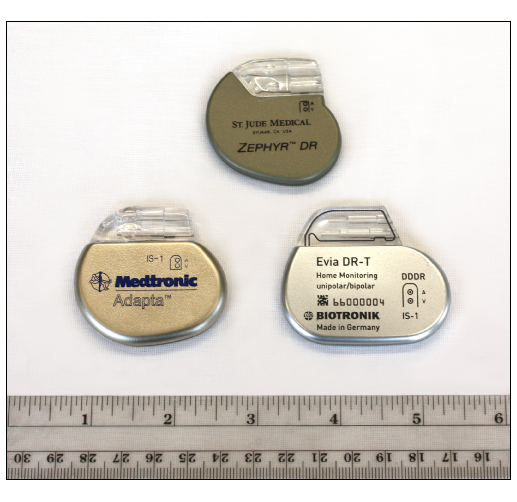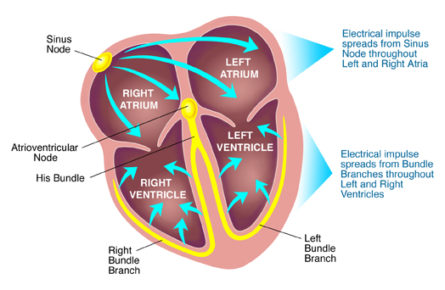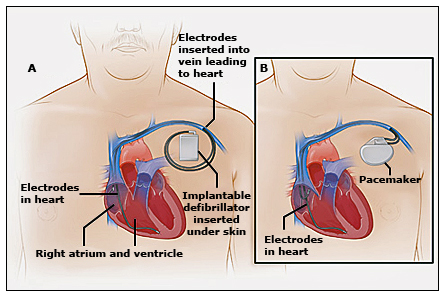Pacemaker
What is a pacemaker?
A pacemaker is a device that sits under the skin near a person’s heart. A pacemaker can treat an abnormal heart rate. “Heart rate” is the term doctors use to describe how fast a person’s heart is beating.
Normally, each person has a built-in electrical system in the heart that controls his or her heart rate. A person’s heart needs to beat at a normal rate in order to pump blood to all parts of the body. Sometimes, a person’s built-in electrical system does not work the right way. This can cause a person’s heart to beat too slowly or too fast.
Different conditions, such as certain heart problems, can cause a person’s heart rate to be abnormal.
How does a pacemaker work?
A pacemaker sends electrical signals to the heart. These signals cause the heart to beat at a normal rate. Most of the time, pacemakers are used to treat a heart rate that is too slow. But pacemakers can also prevent or control a heart rate that is too fast.
Who might need a pacemaker?
A person might need a pacemaker if he or she has an abnormal heart rate and has symptoms. These symptoms can include:
- Fainting
- Feeling dizzy or light-headed
- Feeling your heart pounding
- Feeling confused or more tired than usual
- Trouble breathing
What does a pacemaker look like?

Most pacemakers have 2 parts:
- A “pulse generator” (picture above) – This is a thin metal case with a battery and tiny computer in it. The pulse generator creates and sends electrical signals. A doctor can pre-set the computer to tell the pulse generator when to send electrical signals.
- Wires, also called “leads” – The wires connect the pulse generator to the heart. Electrical signals can travel from the pulse generator through the wires to the heart. Information about how the heart is working can also travel from the heart back to the pulse generator. There is one available pacemaker that works without any wires.
Do all pacemakers work the same way?
No. Pacemakers can work in different ways. A pacemaker can:
- Send electrical signals all of the time or some of the time – Some pacemakers send electrical signals at a steady rate all of the time. Others send electrical signals only when a person’s heart rate is too slow or too fast.
- Send electrical signals to one or more parts of the heart
What is a “temporary pacemaker”?
A temporary pacemaker is a pacemaker that is used for a short time, usually when a person is in the hospital. The pulse generator of a temporary pacemaker is not put inside the body. People might have a temporary pacemaker if they have a condition that will get better soon. They might also have a temporary pacemaker as a short-term treatment until they get a pacemaker put in their body.
What happens after I get a pacemaker?
After you get a pacemaker, you will need to follow up with your doctor on a regular basis. He or she might do a test called an “electrocardiogram” (ECG). An ECG measures the electrical activity in the heart. Your doctor will also check to make sure that your pacemaker is working the right way.
Some people might need to have the pulse generator part of their pacemaker replaced in the future. This is because the battery in the pulse generator usually lasts 5 to 8 years. Wires do not usually need to be replaced.
What else should I do if I have a pacemaker?
If you have a pacemaker, you will need to:
- Avoid certain electric or magnetic sources or equipment – Your doctor will tell you which electric or magnetic sources or equipment you can be near, and which ones you should avoid. For example, people with a pacemaker can be near televisions and radios. But some people with a pacemaker should not walk through a metal detector at the airport. (People who cannot walk through a metal detector can have a security search by hand instead.)
- Let all of your doctors and nurses know that you have a pacemaker – Some procedures and tests are safe for people with a pacemaker, but others are not. For example, most people with a pacemaker should not have a type of imaging test called an MRI scan. Many people with a pacemaker carry an emergency medical card that tells people they have a pacemaker.
Read more about pacemakers – You will be directed to an external page.



